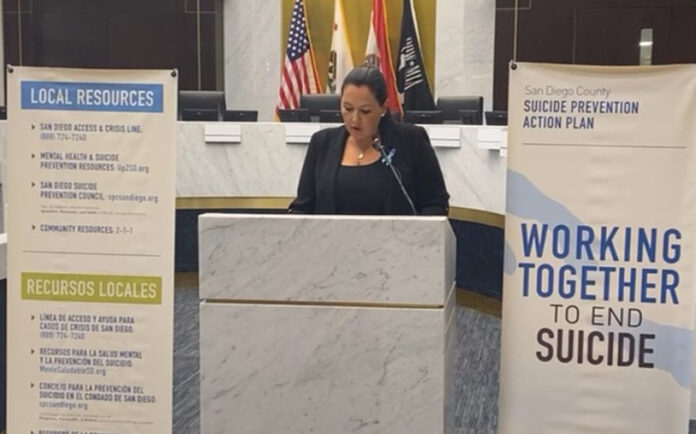World Suicide Prevention Day was Sept. 10, with several events marking the occasion throughout the county including a lighting of candles for those who have lost loved ones due to suicide, and a Survivors of Suicide march at Balboa Park.
On Sept. 7, the San Diego County Suicide Prevention Council released its 2023 “Report to the Community”. At an early morning press conference, the SDSPC Suicide Prevention Program Manager Linda Puebla said after years of declines, confirmed suicide deaths in the County rose to 360 in 2022, slightly more than recorded in 2021. Despite this overall downward trend, suicide death rates increased seven percent for youth and young adults between 10 and 24, and three percent for adults between 25 to 44. In 2021, older adults 65 and older had the highest suicide rate.
“In acknowledgement of the importance of this issue and the impact it was having in our community, over a decade ago, the County developed the San Diego County Prevention Action Plan, which eventually led to the formation of the San Diego County Suicide Prevention Council,” said Puebla.
“In 2018, the Council released an update to the SPAP, which expanded on the efforts, and further establishes the framework and strategies identified by our community as key components community-based suicide prevention. In 2022, the Council continued to invest in suicide prevention, and is leading to enhancements in outreach, training, and an update to our 2018 action plan that will be released next year.”
County Supervisor Chair Nora Vargas supported a $30 million County investment in mental health services and programs in children in youth, said Puebla.
Vargas said the meaning of the press conference was to “continue this vital conversation.”
“In 2022, our preliminary data shows there have been 360 suicide deaths, which is a 1.1% increase to 2021,” she said. “Although there are pending cases until we get a final number, we must never forget these deaths are real family members, friends, and neighbors…One suicide is too many. We know that suicide can be prevented if we know the signs, find the words to talk openly about suicide, and reach out for resources and support.”
Vargas said the data from the report is important in creating programs and initiatives that are most needed.
“What is not in the data is that it does not cover the aspects of the pain, the suffering, and emotional toll the 360 deaths had on individuals, their friends, colleagues, family members, and our communities as a whole. We remain hopeful that our communities are going to remain vigilant, and we will continue to prevent suicides and its devastating consequences. We are going to do that through education, awareness, and strengthening our resources throughout the county.”
Vargas said the stigma around talking about suicide needs to be changed, and that the stigma is stronger in certain communities, such as people of color.
San Diego County Behavioral Health Services Director Dr. Luke Bergmann said despite the fact people are becoming more comfortable talking about behavioral health and suicide, it is a health issue, and it is not talked about in a way that other health issues.
“I had no idea that my dad was struggling to the extent that he was until he called me in the middle of the night, threatening to throw himself off his 12-story balcony,” he said. “We had never had a conversation about any of his feelings about suicide. We talked about everything. But not that. I think that it is a deep telling about the kind of stigma people suffer around this issue. This is a moment where we have an opportunity to change that. That is at the heart of what the Suicide Prevention Council does.”
Bergmann said this is a call to action to talk about behavioral health, suicide, and to learn how to do it in the best ways, and that is the message that needs to be amplified.
“It does prevent suicide,” he said. “We can save lives simply by talking.”
Suicide can be prevented. If you or someone you know needs help, call the Access & Crisis Line at 888-724-7240, seven days a week/24 hours a day. Assistance is available in multiple languages. You can also call the national Suicide and Crisis Lifeline at 988.
To view the 2022 Suicide Prevention Council Report visit spcssandiego.org.















